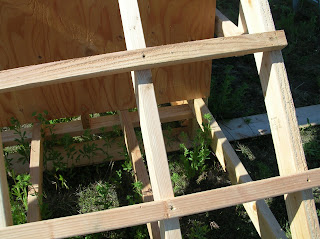There are a lot of talking heads telling you where the economy is going these days. Many will listen to the ones telling them what they want to hear. If you want something else, if you want someone that has no vested interest in your liking what he has to say, no monetary incentive to lie, and a reasonably good track record, I believe the guy over at
Vision Victory manifesto.com has a better grasp on what's going on than anything any of the network TV news has to say. The essence is: The economy is screwed. Don't make money based plans for more than about 10 to 15 years, because the value of US dollar will have tanked by then and enough economic chaos and change will have happened by then that you'll have to make new plans based on whatever economic system reconstitutes after the crash.
He and I share similar plans for the next 10 to 15 years, but there are differences. Here would be my recommended plan by order of importance:
#1: God. Religion is a controversial subject. Many don't believe in God. Regardless of this, I will unapologetically tell you that if you don't have Him on your side, every other thing you are doing is futile. Getting him on your side requires that you do your own homework. Don't assume that conventional wisdom is going to get the job done.
#2: Skills. Develop skill sets that make you a vital organ to society. Luxury items and skills intrinsic to them are the first to become useless.
#3: Basics. Warm Dry Shelter. Clean Water. Food. Work toward obtaining a low maintenance, energy efficient house on two to five acres of land that can be developed in to farm land. Learn to farm. Learn to harvest wild foods. If you can grow food, if you can walk into the wild and find shelter, water, and food with your bare hands or with simple tools, you will have an edge over the vast majority of people that in habit the US today. It's a simple skill you can develop now that nobody else is learning.
#4: Tools. Tools for building, tools for fixing, tools for your skill sets, these are obvious. Guns and knives may not be obvious to you. They are usually seen as weapon, not tools. While they can be weapons, and some are good for little else, the type of gun or knife you buy makes a difference. If you buy an assault riffle and a sword, you are pretty mush stuck with them being weapons. A K-bar and shotgun, on the other hand, are much better suited to being tools. There are a number of things that can be made with just a good hunting/ camping knife, and a shotgun can be used for both hunting and for shooting animals that would eat your livestock or crops. Think utilitarian, not commando and become familiar with your tools.
#5: People. Surround yourself with level headed like minded people that are pursuing a similar plan that can be trusted. The hive effect is a very potent force to be reckoned with. Make it work for you, not against you.
#6: Stockpile. A stockpile of food, water, ammunition, and other consumables is impervious to inflation, but not time, so don't go crazy. Ask yourself: What are the chances of you having to move it without a car? Will it rot before you can use it? Can you stand eating the food you are stocking? Is their enough variety in your stockpile to
keep you healthy? Can the ammunition be used to do what you need it to do? More than a year's supply is probably excessive. After a year, you really need to have a developed an income strategy that doesn't rely on your stockpile. If you haven't, you are in a type of trouble no stockpile in the world is big enough to fix.
#7: Investing. So, you you have a small farm with a reliable well that is paid off. It has an energy efficient house on it that can operate off the electrical grid. You have it packed with a variety of canned foods. Enough to last you and your family for a year. You have a couple of utilitarian guns and you practice with them weekly. Yet you still have income you wish to invest. What do you do with it? Gold and silver are (mostly) inert minerals. As such, their long term real value is reasonably stable just like the ground is reasonably stable. The reason the price of gold has been rising for years is because the dollar has been loosing its real value to inflation. Gold and silver have had a significant value for several thousands of years. The bad news is that in a very small, primitive, crisis economy, gold and silver is frequently valueless for the obvious reasons. You can't eat it, you can't burn it, they're just an inert minerals. Energy on the other hand is always useful, though stored energy is more difficult to store and move. The nature of the stored energy you invest will matter a great deal in a crashed economy. Flammable gases require special containers and special equipment to store and use. Liquid fuels are more stable, but still require containers and some, like gasoline, have additives that will separate and foul the fuel, but with some effort they can still be used in machinery. Solid fuels don't serve well in machinery, but are the most stable and the easiest to store and use. Fire wood must be kept dry or it will rot. Coal it hated by environmentalists, but it is probably the most perfect fuel to stockpile. It is impervious to everything but fire, it won't leak or rot if you just dump it on the ground or bury it in a hole. It will sit around a wait for you longer than you will ever need it too. Governments and thieves will break in and steal gold and silver, but when was the last time you ever heard of someone breaking in and stealing coal? Sure it happens, but it's a much more difficult and desperate act. You will need a place to store it all though, and the amount of space it will take per dollar of investment will be much larger than gold or silver, and reconverting coal into cash could be an unreliable process. Moving your stockpile will be harder as well. Still, I would be far more comfortable stockpiling coal than gold.
 If you are fairly computer literate and want to design something, the I recommend downloading Google SketchUp. There is a learning curve for the program, but they have videos to help you with that. This will help by allowing you to see what you are putting together before you commit materials. I used it to generate a parts list as well. The drawing is not complete, but it's complete enough for what I need it for. Converting a pile of lumber into a chicken tractor with this picture as a guide would not have been too difficult if that was all I had to deal with.
If you are fairly computer literate and want to design something, the I recommend downloading Google SketchUp. There is a learning curve for the program, but they have videos to help you with that. This will help by allowing you to see what you are putting together before you commit materials. I used it to generate a parts list as well. The drawing is not complete, but it's complete enough for what I need it for. Converting a pile of lumber into a chicken tractor with this picture as a guide would not have been too difficult if that was all I had to deal with. The doors open wide and at 4 feet deep, it will be easy to clean.
The doors open wide and at 4 feet deep, it will be easy to clean. A sliding door between the coop and chicken run allows chicken control.
A sliding door between the coop and chicken run allows chicken control. I was unsure whether the chickens could reach the roost, so I added a lower second one.
I was unsure whether the chickens could reach the roost, so I added a lower second one. I ripped 2x4s in half for 2x2 purlins to hook the roofing to. I used old sheets of galvanized roofing on the roof.
I ripped 2x4s in half for 2x2 purlins to hook the roofing to. I used old sheets of galvanized roofing on the roof. I printed off a chicken silhouette I found on the internet and cut the shape out for a decorative window.
I printed off a chicken silhouette I found on the internet and cut the shape out for a decorative window.







